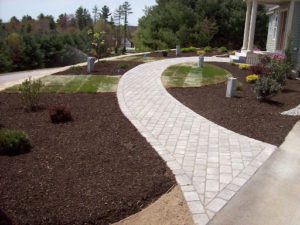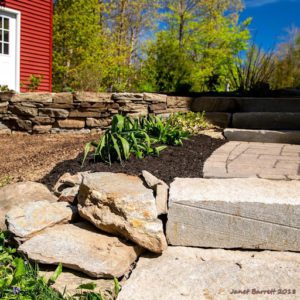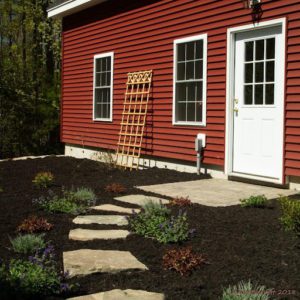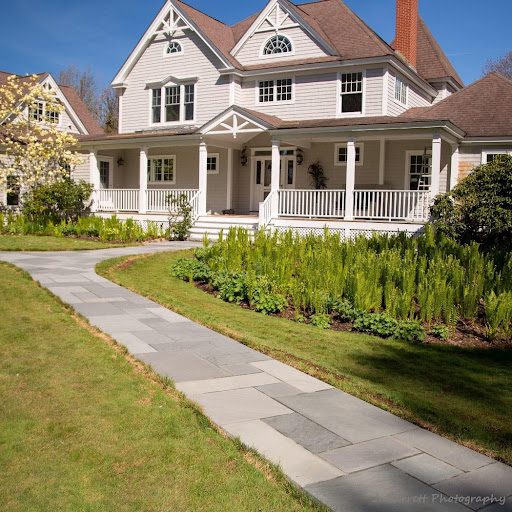To fully understand landscape design, you need to be aware of the two integral parts known as softscape and hardscape. The best way to remember the distinction between the two is the fact that they’re polar opposites of each other and both are equally important to have a functional landscape.
As its name suggests, hardscape constitutes the hard material in your outdoor space like stone, bricks, and concrete. On the other hand, softscape consists of soft materials like shrubs, perennial flowers, trees, and succulents. Softscape lives; hardscape doesn’t.
A professionally designed landscape includes a balance of softscape and hardscape. We’ve all witnessed homes in our neighborhood where we get too much of one of the two elements. A front-yard full of hardscape may have a paved cul-de-sac driveway like a hotel. All it needs is a valet service! While people who’re into swanky landscape design may be into hardscape overload, paving the entire area can make your home look like a commercial building.

The Use of Retaining Walls
A retaining wall is a strong structure made out of brick and stone that’s made to hold the soil in its place. People with houses on sloping grounds or hills use it often to separate the soil at different elevations. This can help prevent soil erosion and help you create an attractive feature in your landscape design.
Having a yard that’s overloaded with softscape can look like a jungle. Your house will look like it belongs to a plant-happy person who has a herd garden, vegetable garden, succulents, roses, ornamental grass, fruit trees, topiary, etc., all growing in chaos with no separation or paths leading to them.
Too much softscape or hardscape in your yard can significantly bring down the curb appeal of your house. It may also decrease the property value of the houses in your neighborhood. As long as the backyard is concerned, the abundance of hardscape won’t create a relaxing paradise, and neither will an unkempt softscape. Therefore, it’s vital to strike a balance.

Hardscape Elements
When you know how hardscape differs from softscape, the characteristics start to make sense.
- Hardscape includes hard but movable components of the landscape design like stones, paving, and gravel.
- It consists of inanimate objects
- Hardscape is unchanging and solid
- Some examples of hardscape include pavers for patios and paths, retaining walls, water features, outdoor kitchens, driveways, decks, and gazebos.
- They can be natural, like made of stone, or manmade, like a planter.
- The materials used in hardscapes have varying environmental impacts. Pavement can prevent the soil from soaking a lot of water leading to runoff. Because of that, contaminants can get into the streams.
Hardscape can immensely benefit your landscape design because it can reduce soil erosion and ensures that the ground stays intact.

Softscape Features
Plants can be found in expansive shapes, colors, sizes, and textures. When choosing softscape for your landscape, you should:
- Consider that all the soft and horticultural components of the landscape are softscapes, from ground covers and shrubs to flowers and trees.
- Evolve and change the softscape constants as they adapt and grow to the climatic conditions of your garden.
- Think about how they feel to touch. If they’re soft, it’s a softscape, like grass and leaves.
- Note that, which brick is made with soft sand, it’s not a softscape.
The Importance of Balance Between Hardscape and Softscape
The best-looking landscape will have elements from both softscape and hardscape. A landscape that purely focuses on gravel, rock, and paved driveway is a hardscape overkill, which is harsh to the eye. Similarly, a home with overflowing shrubs, trees, wildflowers, a lack of walls, and walkways can make it seem unwelcoming and jungle-like.
The harmony lies in the peaceful balance of hard and soft features that can create harmony. The result of perfect balance will be a landscape that’s inviting and relaxing for you and your guests to enjoy.
How To Go About Creating this Outdoor Paradise?
For starters, you should begin with the hardscape as it can create the shape and boundary of the landscape design. As the features of the hardscape are more technical, they usually require help from professional landscape designers. Skilled landscape artists can help you choose between different hardscape features so that you decide what will complement the look of your house and the plants you plan on installing.
Hire The Masonry Experts
You must hire professionals at Stone Solutions Maine for top-of-the-line masonry. Their trained team offers outdoor landscaping services in Saco. They ensure that the landscaping is done to perfection and within time.
Their landscaping services also include stonewalls and veneers, firepit and fireplace building, patios, driveways, and more. They also offer our services in South Portland, Falmouth, and Yarmouth, ME.
Contact us today to upgrade your outdoor space.

